Sequencing Defined – Putting Things in Order, Literally!
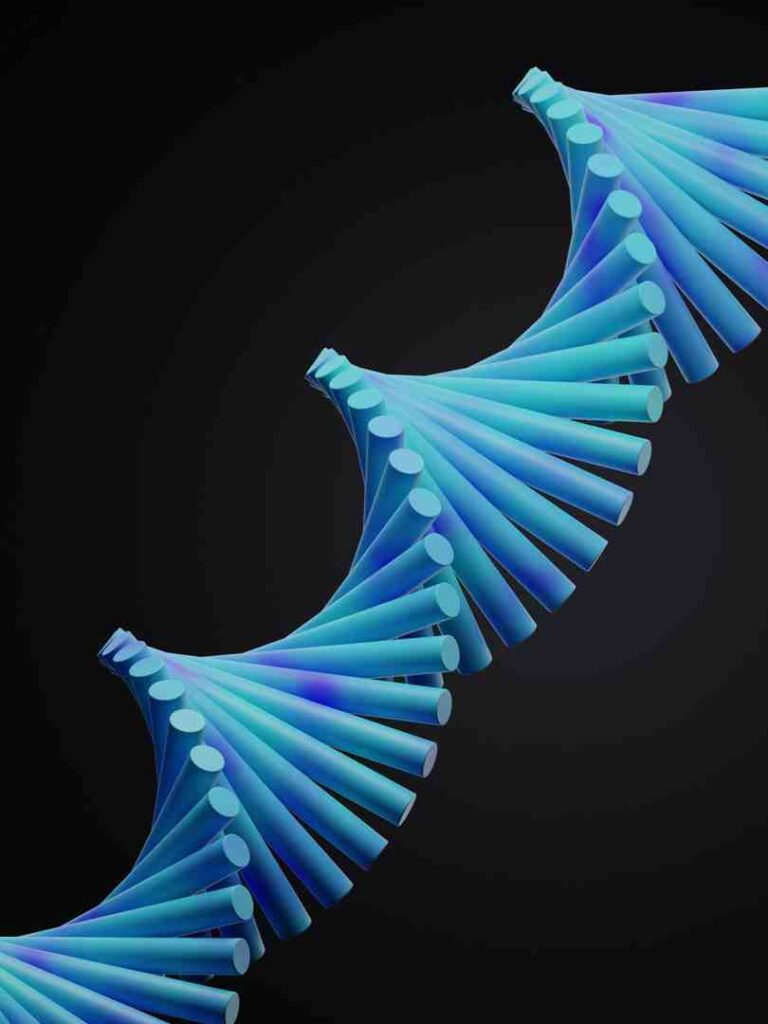
Why Understanding Sequencing Matters in Today’s Data-Driven World
The definition of sequencing is fundamentally about determining the precise order of elements in a series—whether that’s arranging events chronologically, organizing manufacturing processes, or decoding the genetic blueprint of life itself.
Quick Definition:
- Sequencing = The process of determining the specific order of items in a series
- Applications = From DNA analysis to supply chain management to data processing
- Impact = Enables everything from personalized medicine to efficient manufacturing
At its core, sequencing is about putting things in their proper order. Like reading a book, letters must be in the right sequence to form words, words must be sequenced correctly to create sentences, and sentences need proper sequencing to tell a coherent story.
Sequencing has become revolutionary in fields like genomics, where scientists can now read the 3 billion base pairs in human DNA for just a few thousand dollars—a process that once cost $100 million. This dramatic shift has transformed how we approach medicine, disease prevention, and drug findy.
But sequencing isn’t limited to biology. It’s equally crucial in:
- Manufacturing – optimizing assembly line processes
- Logistics – managing supply chain efficiency
- Data science – analyzing time-series information
- Communication – organizing information for clarity
I’m Maria Chatzou Dunford, CEO and Co-founder of Lifebit. With over 15 years in computational biology and genomics and key contributions to the Nextflow framework, my expertise spans from sequencing’s computational principles to its transformative applications in precision medicine and biomedical data integration.
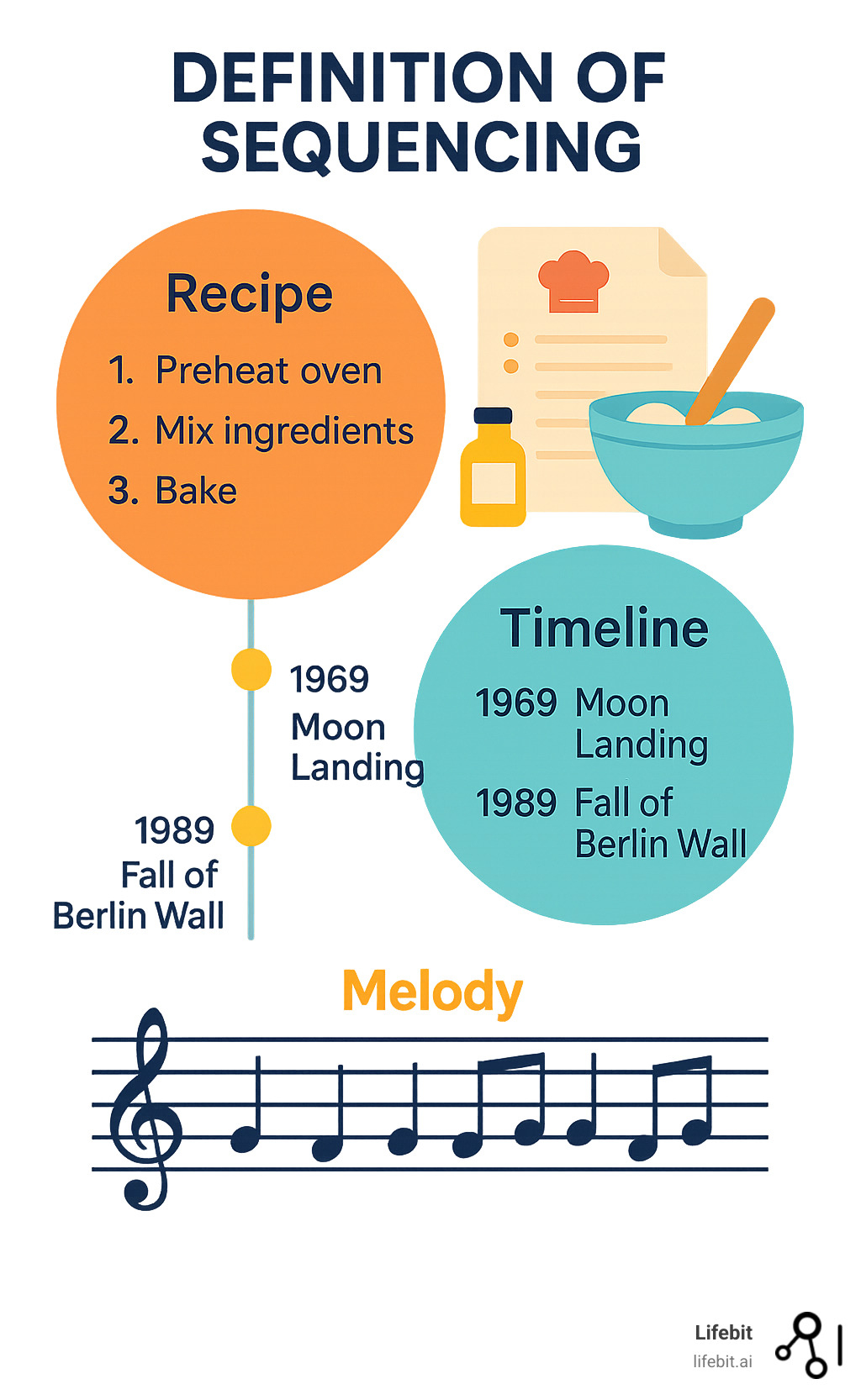
The Fundamental Definition of Sequencing
A sequence is a series of items arranged in a particular order, like the steps in a recipe or the chapters in a book. According to Merriam-Webster, a sequence is “a continuous or connected series” or “an order of succession.” Picture a string of pearls—the deliberate arrangement is the sequence.
Sequencing is the active part—it’s the process of figuring out or creating that order. If a sequence is the finished puzzle, sequencing is putting the pieces together in the right spots.
The difference might seem small, but it’s significant. When you listen to your voicemails in sequence, you’re following an existing order. But when you sequence the steps for assembling a bookshelf, you’re actively creating that order. The encyclopedia article about sequence from Britannica dives deeper into how this fundamental concept shapes everything around us.
This concept of arranging things in the right order touches virtually every part of our lives. From the stories we tell to the products we manufacture, sequencing quietly works behind the scenes to make everything flow smoothly.
The Mathematical Foundation of Sequencing
Mathematically, sequences form the backbone of numerous fields. In mathematics, sequences can be arithmetic (where each term increases by a constant difference), geometric (where each term is multiplied by a constant ratio), or follow more complex patterns like the famous Fibonacci sequence (0, 1, 1, 2, 3, 5, 8, 13…).
These mathematical principles directly apply to real-world sequencing challenges. Algorithm design relies heavily on understanding how to optimize the order of operations. Computer scientists use concepts like Big O notation to analyze how different sequencing approaches affect performance as data sets grow larger.
In statistics and probability, understanding sequences helps predict future events based on historical patterns. Weather forecasting, stock market analysis, and even sports analytics all depend on identifying meaningful patterns within sequences of data points.
Information theory, developed by Claude Shannon, treats all communication as sequences of symbols. This foundation enables everything from data compression algorithms to error-correction codes that ensure your text messages arrive intact.
Sequencing in Communication and Storytelling
Good communication depends on proper sequencing. A jumbled recipe or a movie that jumps randomly in time is frustrating because the order is wrong. When we write, present, or tell stories, we constantly make choices about what comes first, second, and third to ensure we are understood.
Chronological order is the most familiar type. We naturally expect events to unfold in time order, which is why historical accounts and news stories typically follow this pattern. However, skilled storytellers sometimes break chronological order deliberately—think of movies like “Pulp Fiction” or “Memento”—to create specific emotional effects.
Cause-and-effect sequencing is another powerful approach, where we might start with a problem and then explore its consequences, or work backward from an outcome to understand its cause. This approach is particularly effective in scientific writing, investigative journalism, and problem-solving scenarios.
Spatial sequencing organizes information based on physical location or layout. Travel guides, architectural descriptions, and technical manuals often use this approach to help readers steer through physical or conceptual spaces.
Importance-based sequencing prioritizes information by significance, starting with the most critical points. News articles use the “inverted pyramid” structure, placing the most newsworthy information first, while business presentations often lead with key findings before diving into supporting details.
Narrative structure takes sequencing to an art form. Every compelling story follows a carefully crafted sequence: beginning, rising action, climax, falling action, and resolution. Each plot point builds on the last, creating momentum and meaning. The Hero’s Journey, identified by Joseph Campbell, represents a universal sequence found in myths and stories across cultures.
Think about instruction manuals. The best ones use clear sequencing with transition words like “first,” “then,” and “finally.” They guide you step by step, because when sequencing breaks down, confusion follows. Technical writers spend considerable effort organizing complex procedures into logical, sequential steps that minimize user error.
Sequencing in Logistics and Manufacturing
In any warehouse or factory, sequencing is critical. Getting the order right drives efficiency, cost savings, and customer satisfaction. In logistics, sequencing means organizing tasks, materials, and products in the most effective order possible.
Supply chain management relies heavily on sequencing. Products must move from suppliers to manufacturers to distributors to retailers in a carefully choreographed dance. When one step gets out of sequence, delays ripple through the entire system. The COVID-19 pandemic highlighted how fragile these sequences can be—disruptions in one region caused shortages worldwide.
Demand forecasting uses historical sequence data to predict future needs. Retailers analyze seasonal patterns, trending products, and consumer behavior sequences to optimize inventory levels. Amazon’s recommendation engine processes millions of purchase sequences to suggest products you might want next.
One example is Just-in-Sequence (JIS) manufacturing. Instead of stockpiling parts, manufacturers receive components in the exact order they’ll be installed on each product. Picture a car assembly line where the red seat for car #47 arrives just as car #47 reaches the installation station. This precise sequencing reduces inventory costs and speeds up production.
Lean manufacturing principles, pioneered by Toyota, emphasize eliminating waste through optimal sequencing. The kanban system uses visual signals to sequence production based on actual demand rather than forecasts. Each step in the process signals the previous step about what to produce next, creating a smooth flow.
Assembly lines are the most visible example of sequencing in manufacturing. Each worker performs a task in a specific order as the product moves along a predetermined path. It’s a performance where timing and order are everything. Modern assembly lines use sophisticated software to optimize worker sequences, minimize bottlenecks, and adapt to changing product mixes.
Quality control also depends on proper sequencing. Inspections must occur at specific points in the manufacturing process to catch defects early. Testing sequences are designed to identify the most common problems first, saving time and resources.
Good sequencing in logistics creates process optimization. When everything flows in the right order, waste decreases, efficiency increases, and inventory management becomes more manageable. Without it, even the most advanced systems would grind to a halt.
Warehouse management systems use complex algorithms to sequence picking routes, minimizing the distance workers travel while fulfilling orders. During peak seasons like Black Friday, these sequencing optimizations can mean the difference between meeting customer expectations and disappointing them.
Decoding the Blueprint of Life: DNA Sequencing
DNA sequencing is where the concept becomes truly life-changing: it’s the process of reading the genetic code that makes you, you.
Think of DNA as nature’s instruction manual, written in a four-letter alphabet: Adenine (A), Thymine (T), Cytosine (C), and Guanine (G). These building blocks spell out everything from your eye color to how your body processes medications. Changing one genetic letter can have profound effects on human health.
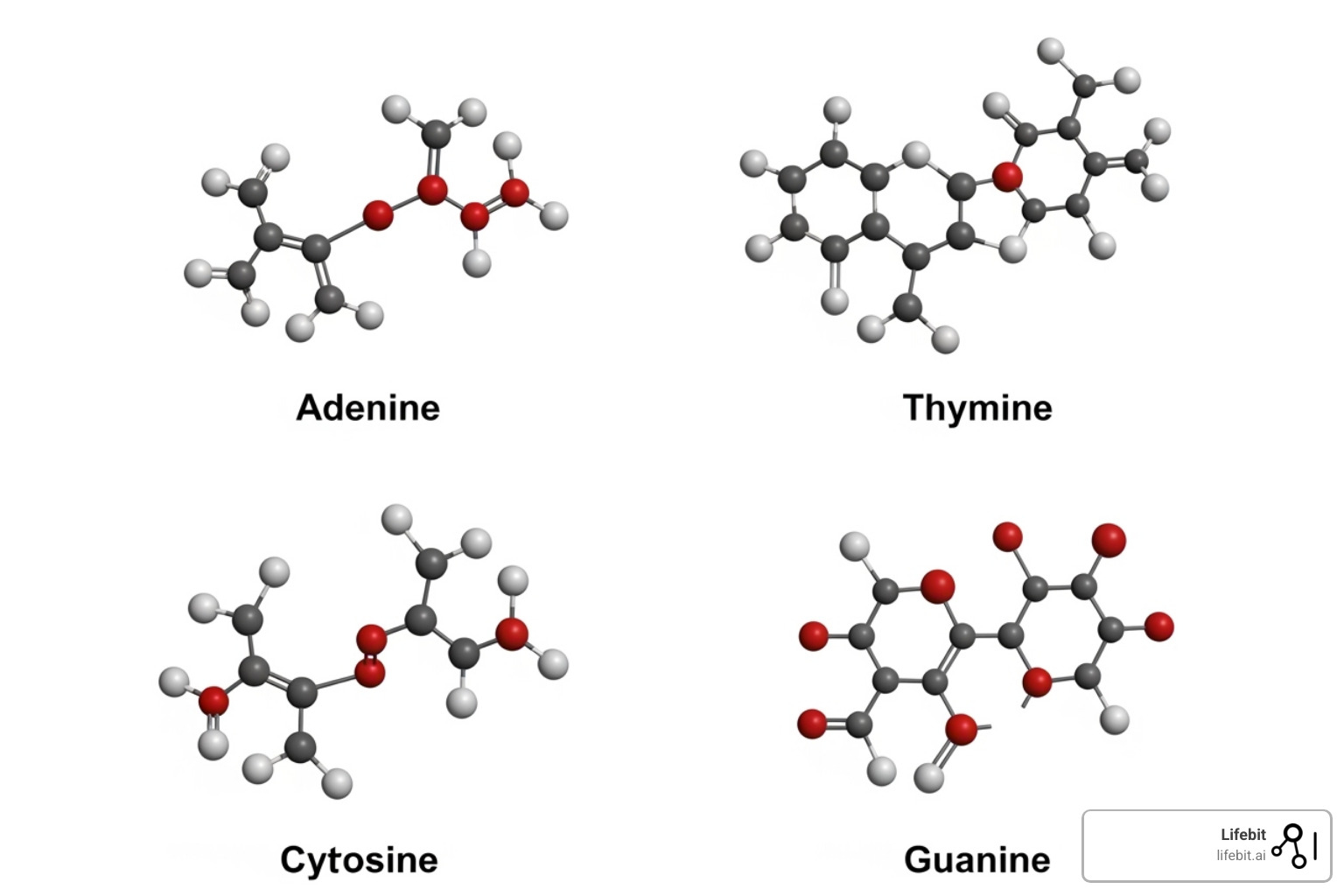
The scale is immense: your genome contains roughly 3 billion base pairs, and scientists can now read the entire genetic book. What makes this even more remarkable is how accessible this technology has become.
Not long ago, sequencing a single human genome cost around $100 million and took years. Today, that same genome can be sequenced for just a few thousand dollars in a matter of days. It’s like going from a room-sized computer that cost millions to a smartphone in your pocket.
This dramatic shift means some laboratories can now sequence over 100,000 billion bases per year. This represents millions of people getting answers about their health, researchers finding new treatments, and doctors making more precise diagnoses.
The Historical Journey of DNA Sequencing
The story of DNA sequencing begins in the 1950s when Rosalind Franklin’s X-ray crystallography revealed DNA’s double helix structure. This findy laid the groundwork for understanding how genetic information is stored and organized.
In 1965, Robert Holley achieved the first nucleic acid sequence—a transfer RNA molecule with just 77 nucleotides. This breakthrough proved that sequencing was possible, though the methods were painstakingly slow.
The 1970s brought advances. Allan Maxam and Walter Gilbert developed a chemical sequencing method, while Frederick Sanger created the chain-termination method that became the gold standard. Sanger’s approach used modified DNA building blocks that stopped synthesis at specific points, creating fragments of different lengths that could be separated and read.
The Human Genome Project, launched in 1990, represented the first large-scale sequencing effort. This international collaboration took 13 years and $2.7 billion to sequence the first human genome. The project required developing new computational tools, establishing quality standards, and creating databases to store and share genomic information.
Parallel efforts by Craig Venter’s Celera Genomics introduced shotgun sequencing, which broke DNA into random fragments and used computational methods to reassemble them. This approach was faster but required more sophisticated algorithms to handle the complexity.
The Evolution of DNA Sequencing Technology
The technology’s evolution began with Fred Sanger in the 1970s, who developed what became known as Sanger sequencing. This method was accurate but slow, like reading a book one letter at a time. Sanger sequencing could process about 1,000 bases per day per machine, making large-scale projects extremely time-consuming.
The Human Genome Project’s completion in 2003 proved that reading entire genomes was possible but highlighted the need for faster, cheaper methods. The project’s success sparked the development of high-throughput sequencing technologies.
Enter Next-Generation Sequencing (NGS), which was like speed-reading an entire library simultaneously. NGS platforms process millions of DNA fragments in parallel, turning a months-long process into an overnight one. Illumina, 454 Life Sciences, and Ion Torrent became major players in this revolution.
Pyrosequencing became popular because it could sequence roughly 100 megabases (now up to 400 megabases) in just seven hours with a single machine. The improvement has been so rapid that scientists compare it to Moore’s Law in computing—costs plummeting while performance skyrockets.
Illumina’s sequencing-by-synthesis technology uses fluorescently labeled nucleotides and advanced imaging to read millions of DNA fragments simultaneously. Each sequencing run can generate hundreds of gigabases of data, enough to sequence multiple human genomes.
Ion Torrent took a different approach, detecting hydrogen ions released during DNA synthesis. This method eliminated the need for fluorescent labels and expensive imaging equipment, making sequencing more accessible to smaller laboratories.
The latest chapter involves Third-Generation Sequencing or long-read sequencing. Pacific Biosciences (PacBio) and Oxford Nanopore Technologies developed methods that can read much longer stretches of DNA—sometimes entire chromosomes in a single read. These technologies help scientists understand complex parts of the genome that were previously difficult to solve, such as repetitive regions and structural variations.
Single-molecule sequencing represents the cutting edge, where individual DNA molecules are sequenced in real-time. Oxford Nanopore’s technology threads DNA through tiny protein pores, measuring electrical changes as different bases pass through. This approach enables portable sequencing devices small enough to take into the field.
For those interested in diving deeper into these transformative technologies, there’s excellent information available about what next-generation sequencing is.
Why the Definition of Sequencing in Genomics is a Game-Changer
Genomic sequencing is a game-changer because it fundamentally alters our approach to health and disease. The ability to quickly and affordably decode a genetic blueprint has opened doors we didn’t know existed.
Personalized medicine is the most exciting application. Instead of a “one-size-fits-all” approach, doctors can tailor medications and dosages based on your unique genetic makeup, making treatments more effective. Pharmacogenomics studies how genetic variations affect drug responses, helping doctors choose the right medication at the right dose for each patient.
For disease diagnosis, sequencing is a top medical detective tool. Families searching for answers about rare genetic conditions can now get definitive diagnoses in weeks. Whole exome sequencing focuses on protein-coding regions where most disease-causing mutations occur, providing a cost-effective diagnostic approach.
Cancer treatment has been revolutionized by tumor sequencing. Oncologists can identify specific mutations driving each patient’s cancer and select targeted therapies accordingly. Liquid biopsies analyze circulating tumor DNA in blood samples, enabling non-invasive monitoring of treatment response and disease progression.
Prenatal screening uses sequencing to detect chromosomal abnormalities and genetic disorders before birth. Non-invasive prenatal testing (NIPT) analyzes fetal DNA circulating in maternal blood, providing accurate results without the risks associated with invasive procedures.
During disease outbreaks, sequencing is a public health superpower. Scientists can rapidly identify viral strains, track their spread, and understand their evolution. The COVID-19 pandemic demonstrated this power—researchers sequenced the SARS-CoV-2 genome within weeks of the outbreak and continued monitoring viral evolution to identify new variants. The role of genomic analysis of viral outbreaks has proven invaluable for public health responses.
Newborn screening programs now use sequencing to test babies for treatable genetic conditions, catching problems before they become serious. Early intervention can prevent intellectual disability, organ damage, and other serious complications.
Agricultural genomics applies sequencing to improve crop yields, disease resistance, and nutritional content. Scientists sequence plant and animal genomes to identify beneficial traits and accelerate breeding programs.
The power of genomic sequencing lies in its ability to transform genetic information into actionable medical insights, making healthcare more precise and personalized. As sequencing costs continue to fall and analysis tools improve, genomic medicine is becoming standard care rather than experimental treatment.
Beyond DNA: Sequencing Other Biological Molecules
While DNA sequencing grabs the headlines, the definition of sequencing extends far beyond our genetic blueprint. If DNA is the master cookbook, then RNA is the individual recipe card, and proteins are the meals being prepared. Each step involves determining a precise sequence, and each tells us something different about how life works.
This dance of molecular information follows the Central Dogma of molecular biology: DNA makes RNA, and RNA makes protein. It’s a relay race where each molecule carries information in a specific sequence to the next stage.
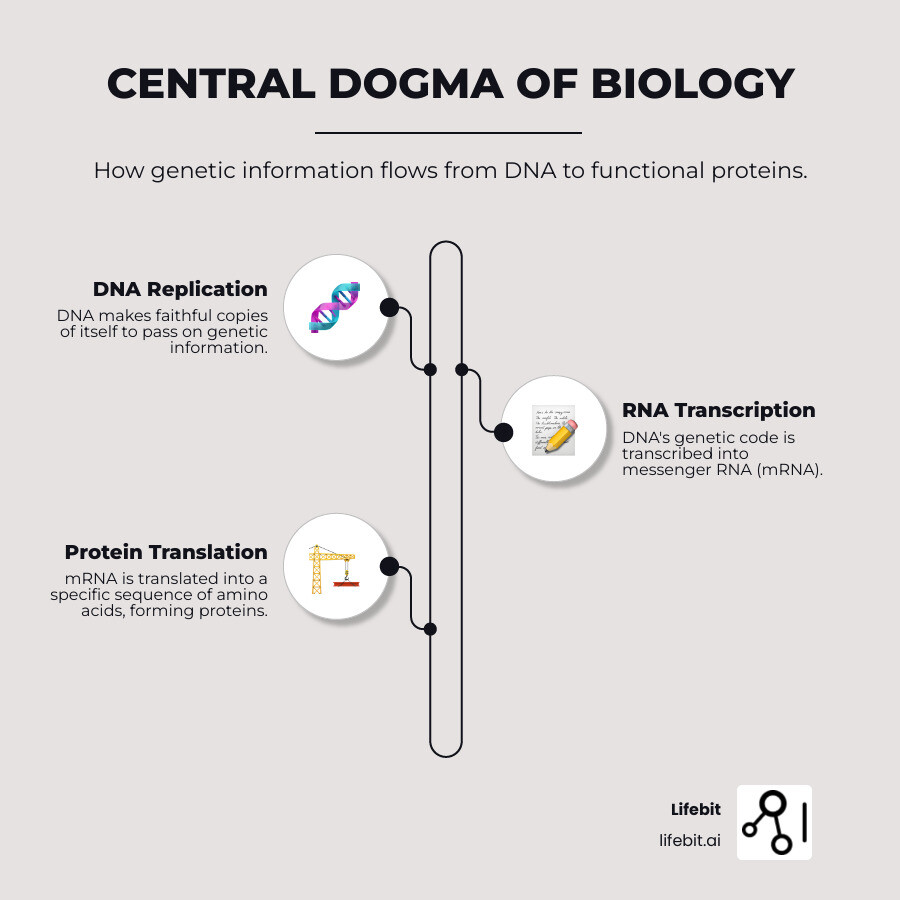
Understanding the sequence of these different molecules gives us a complete picture of biological function—not just the instruction manual (DNA), but also which instructions are being followed (RNA) and what’s being built (proteins).
RNA Sequencing (Transcriptomics)
RNA sequencing (RNA-Seq) reveals what’s happening in your cells right now. While your DNA is mostly static, your RNA constantly changes based on cellular needs. Think of RNA as your cell’s to-do list.
RNA-Seq works by determining the order of nucleotides in RNA molecules. Because RNA is less stable than DNA, scientists typically convert it into more stable complementary DNA (cDNA) before sequencing it.
This field, called transcriptomics, has revolutionized how we understand gene activity. Instead of just knowing what genes you have, RNA sequencing tells us which genes are active and how hard they’re working. It’s the difference between having a list of tools in a workshop versus knowing which tools are currently in use.
RNA sequencing is valuable for disease research because it can show how gene expression changes in conditions like cancer. It’s also crucial for drug findy, helping researchers understand how potential treatments affect cellular function.
Protein Sequencing (Proteomics)
If DNA is the instruction manual and RNA is the to-do list, then proteins are the workers getting things done in your cells. Protein sequencing determines the order of amino acids, which is critical because it dictates what each protein can do.
The sequence of the 20 different amino acids determines how a protein folds into its final three-dimensional shape. If it folds wrong, it won’t work properly, which is why knowing the exact amino acid sequence is so important.
Proteomics—the study of all proteins in a cell—faces unique challenges. Proteins can be chemically modified after they’re made through post-translational modifications, which can completely change their behavior. This makes protein analysis more complex but also more informative.
Modern protein sequencing relies on mass spectrometry, which breaks proteins into smaller pieces and measures their mass. Computational methods then piece together these fragments to determine the original amino acid sequence.
While traditional methods like Edman degradation were slow, mass spectrometry has made protein sequencing much more efficient.
Understanding protein sequences is essential for drug design, as most medicines interact with specific proteins. Knowing a protein’s sequence and structure allows for the design of drugs that fit it like a key in a lock, making modern medicine more targeted and effective.
The Broader Impact of Sequencing Across Industries
The principles of sequencing extend far beyond the lab, touching nearly every aspect of the modern world. Anytime you put things in order to solve a problem or create something meaningful, you’re using sequencing.
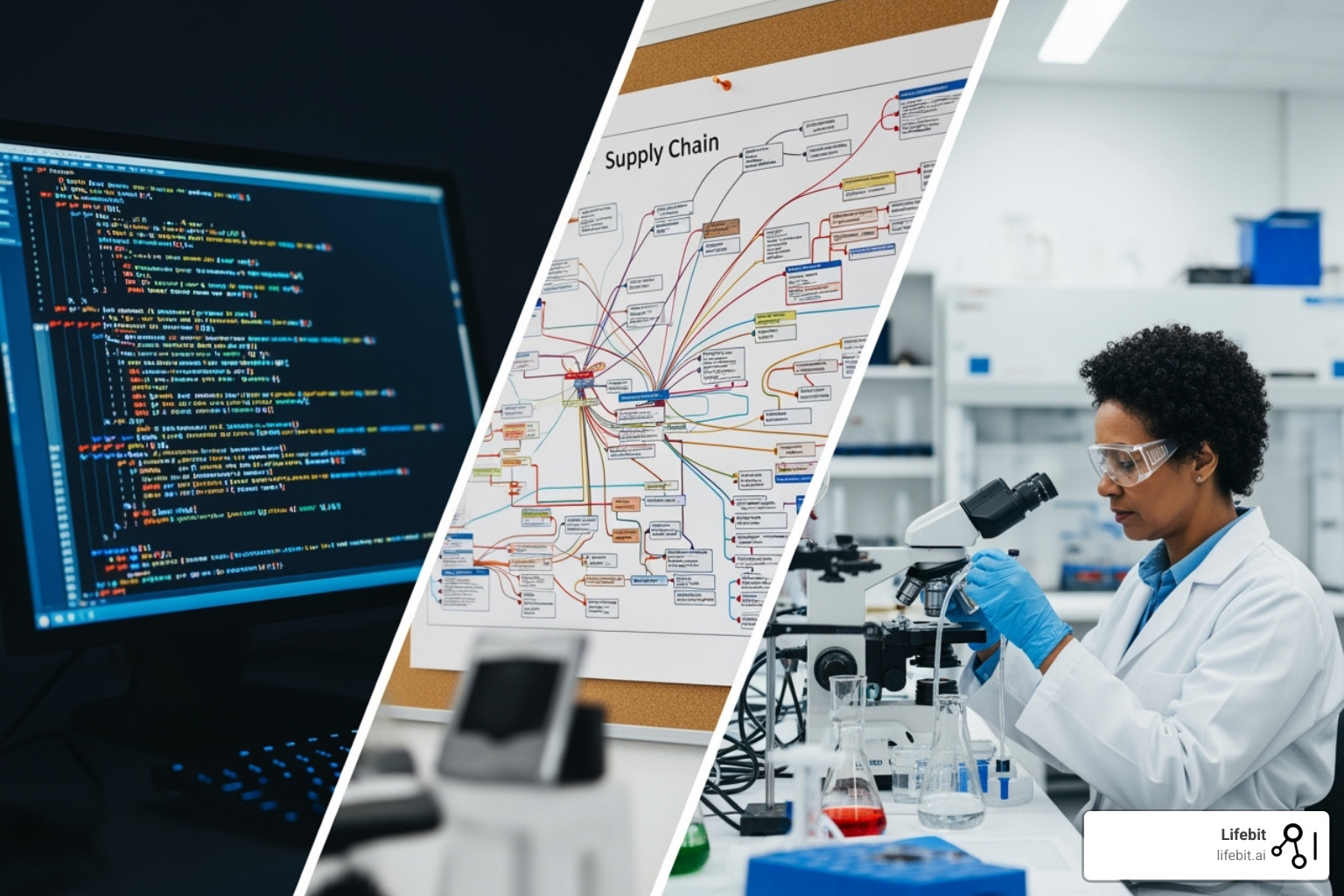
From the algorithms that power our smartphones to the music we stream, sequencing is the invisible force that brings order to complexity. This fundamental concept has become a powerful tool for interdisciplinary applications, data analysis, automation, and problem-solving.
The Critical Role of the Definition of Sequencing in Data Science
In our data-driven world, most valuable data comes in sequences, and understanding them is the key to open uping insights.
Algorithms don’t just randomly grab data; they follow specific sequences of operations to transform raw information into meaningful results. When you check your bank balance, the system sequences through verification, lookup, and calculation steps in a precise order.
Time-series analysis is the most obvious example of sequencing in data science. Whether tracking stock prices, monitoring weather data, or analyzing patient health metrics, the sequence tells the story. A stock price of $100 means nothing without knowing if it came before or after a $50 reading.
In bioinformatics and computational biology, sequencing is fundamental. Scientists use computational methods to compare, align, and understand evolutionary relationships between sequences. The data processing pipelines that handle genomic information must follow strict sequences to ensure accuracy.
At Lifebit, we see this daily. Our federated AI platform orchestrates complex analytical workflows where the sequence of operations is crucial for maintaining data integrity. When dealing with sensitive health data across institutions, getting the sequence right is essential for scientific validity and regulatory compliance.
Sequencing in Music and Entertainment
The artistic power of sequencing is evident in music and entertainment. If you’ve ever hummed along to a song or gotten lost in a movie, you’ve experienced it.
Music sequencers are the digital tools that help artists arrange sounds in time. They capture musical ideas—notes, rhythms, and effects—and play them back in the right order. MIDI technology revolutionized this by recording the sequence of musical events, not just audio. Digital Audio Workstations (DAWs) are essentially tools for building musical sequences.
These sequences combine to create something greater than their parts. A sequence of notes becomes a melody. Multiple melodies create harmony. Rhythmic sequences provide the beat.
Film editing and video production rely on sequencing to control how stories unfold. Editors carefully sequence shots to build tension, reveal information, and guide emotions. The narrative flow depends entirely on presenting visual and audio elements in the right order.
Frequently Asked Questions about the Definition of Sequencing
After exploring the fascinating world of sequencing, you might have some lingering questions. Let’s tackle the most common ones.
What is the simplest definition of sequencing?
The simplest definition is the process of determining the specific order of items in a series. Whether it’s letters in a gene, steps in a recipe, or notes in a melody, sequencing is about establishing a clear, logical order. Once you understand this concept, you can recognize it everywhere, from daily routines to complex algorithms.
What is the difference between a sequence and sequencing?
A “sequence” is the finished product—the ordered list itself (e.g., the DNA string ATTCGAAC…). “Sequencing” is the action—the process of figuring out that order. You perform sequencing to find a sequence.
Why has DNA sequencing become so important?
DNA sequencing is important because it allows us to read the “code of life,” which has revolutionized medicine. It enables personalized treatments based on a patient’s unique genetics, leading to more effective therapies with fewer side effects. It also allows for faster diagnosis of genetic diseases and rapid responses to viral outbreaks by helping scientists develop vaccines and treatments quickly. This fundamental knowledge is the foundation for countless future medical breakthroughs. Platforms like Lifebit’s federated AI solution are crucial for analyzing this vast amount of genetic data securely to generate life-saving insights.
Conclusion: The Unifying Power of Order
The concept of order, or sequencing, is a universal force. From the precise arrangement of molecules in our DNA to the logical flow of ideas in a sentence, and from an optimized manufacturing plant to a symphony, sequencing is fundamental to how we understand, create, and advance.
The transformative impact of sequencing is most evident in genomics, where reading the genetic code has ushered in an era of personalized medicine. When we can decode the 3 billion base pairs in human DNA for just a few thousand dollars—down from $100 million—we are opening up the blueprint of life.
But the influence of sequencing extends far beyond the lab. In our data-driven world, establishing order is essential for complex data analysis and automation. Whether tracking stock prices, optimizing supply chains, or creating a film, sequencing principles guide us toward clarity and efficiency.
Looking ahead, the importance of sequencing will only grow. The convergence of artificial intelligence and big data analysis is creating unprecedented opportunities to extract meaning from vast amounts of sequenced information, especially in genomics.
The challenge is no longer just generating sequence data, but making sense of it. This is where platforms like Lifebit’s federated AI solution are crucial. Our platform is designed to provide secure, real-time access to vast biomedical and multi-omic data, enabling compliant research and pharmacovigilance across biopharma, governments, and public health agencies.
By securely analyzing these massive sequencing datasets, we help turn complex biological code into life-saving insights. Our federated approach allows researchers to collaborate across institutions while maintaining data privacy and security—essential when dealing with sensitive genetic information.
The journey of sequencing is far from over; we are just scratching the surface of its potential. As we continue to generate more sequence data than ever before, the real magic happens when we can connect the dots across different types of information—genomic, clinical, environmental, and beyond.
To learn more about how we harness the power of sequencing data and transform it into actionable insights, explore how to harness the power of sequencing data with our federated platform. The future of sequencing isn’t just about reading the code—it’s about understanding what it means and using that knowledge to improve lives.

